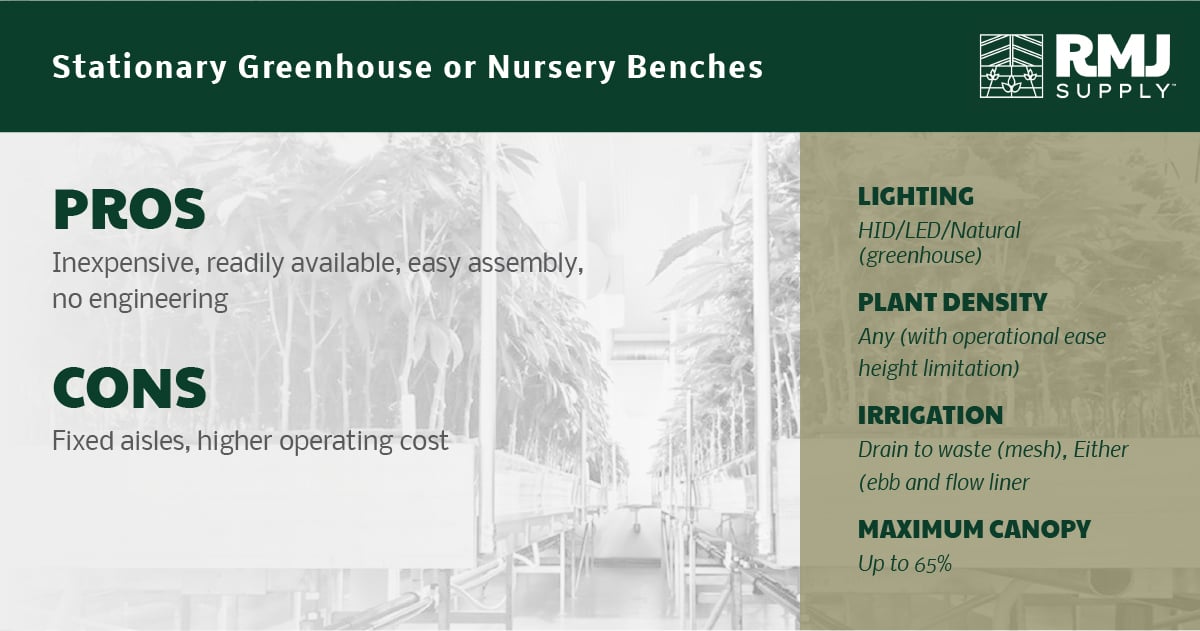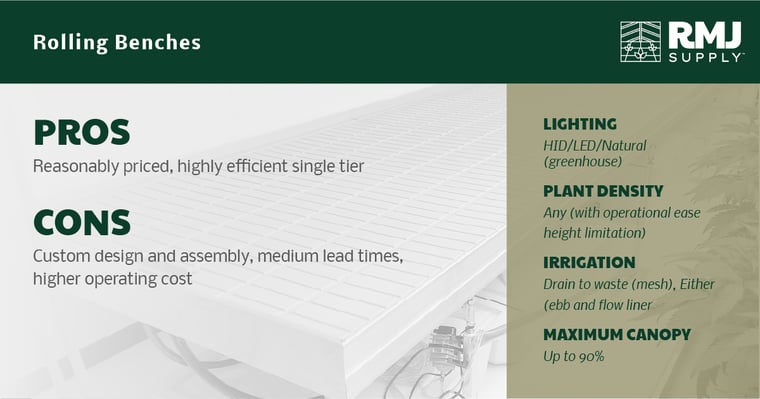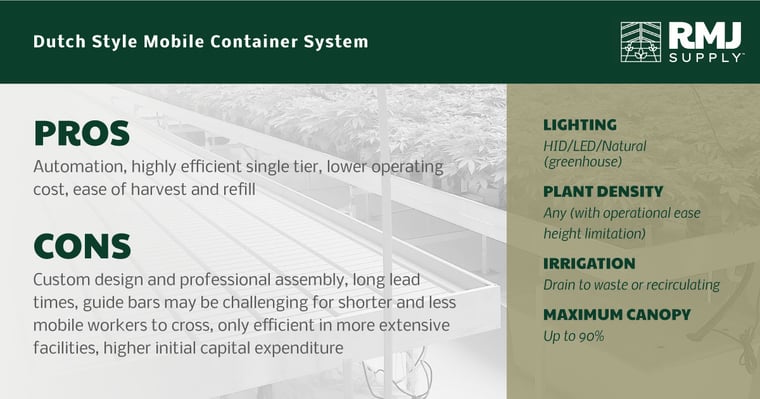A Guide for Intelligent Benching to Maximize Your Cultivation Space
When deciding what style of grow benches or racks to implement at your greenhouse or indoor facility, there are several factors to consider. Each part of the cultivation is connected from lighting to irrigation to container handling, and you must consider process compatibility. This guide reviews each type of bench or racking to help you determine which system best fits your company’s needs.
Full canopy is expressed as the approximate percentage of a greenhouse or indoor grow room occupied by plants. Vast areas allow for less aisle at the end of benches or racks and greater space utilization. Limiting factors such as roof support columns, equipment, and any desired functional space beyond the minimum fire code usually restricts this value further.
Stationary Greenhouse or Nursery Benches
A stationary greenhouse bench is the classic nursery bench. These benches most commonly have a mesh bottom that drains to the ground, and these benches can also be equipped with an ebb and flow liner to control irrigation runoff.

Rolling Benches
Rolling benches slide back and forth on long metal tubes to create working aisles as needed. The distance the bench will slide depends on the width of the table and manufacturer. These benches come standard with anti-tip safety features. Rolling benches can eliminate over 70% of static aisle ways in a well-designed greenhouse or indoor facility and may be equipped with a mesh bottom or an ebb and flow liner.

Dutch-Style Rolling Benches (Container Table System)
These fully mobile container systems are a must for larger facilities seeking to automate production and lower operating costs. Benches glide effortlessly back and forth over guide bars and shift perpendicularly on transfer lines at the end of aisles. A gutter system is used to collect irrigation runoff and employed with recirculating flood or top-drip irrigation. These systems are usually only practical in multi-acre greenhouse facilities with long runs because of the additional space transfer lines require. Entire container tables are removed at harvest to a separate area with clean table replacements filled with plants taking their place for maximum turnover efficiency and ease. Mechanical automation can be used to move tables from position to position, and large industrial steam wash machines lower operational costs with a short ROI proposition.

Stationary Vertical Racks
Immobile vertical racking has been losing relevancy quickly with the market moving to primarily mobile options but still holds relevance in some applications. Vertical rack systems are ideal for large amounts of squat plants with little to no vegetative growth time. LED lights are fastened to the tier above while the top level uses HID lighting. In energy abundant greenhouses, natural light is used primarily for the upper-tier with supplementary LEDs below. These systems typically require more complex irrigation and air movement systems to keep climate even across the different levels. Some manufacturers even advertise these systems up to 35’ high.

Mobile Vertical Racks
Most vertical rack systems are similar to library archival systems and are a popular niche within emerging indoor CET cultivation. Racks may slide back and forth to create working aisles either by an electric motor or a hand crank, and unique flexible electrical and irrigation connections are required. Still, power consumption and HVAC requirements for a typical two-tier system are roughly equivalent to a single-tier mobile bench HID buildout.

Other Forms of Plant Holding Systems
Hydroponic Gutters
Inexpensive and functional, these gutters offer a lower entry ROI but are not inherently well suited for cannabis. Gutter systems are impractical for high-density early growth, less space-efficient on average than stationary benching, and possess no natural structure for a plant support system.
DWC/NFT Pipe Systems
Plant roots grow in hydroponic pipes with no medium. These systems can be designed to efficiencies similar to static racking but are more prone to catastrophic crop loss when irrigation systems temporarily fail. Expert engineers and operators must experience repeatable success with these systems on a commercial scale.
Vertical Dutch Style Mobile Benching
Rare to find, these systems are the Aston Martin’s of automation in plant benching. They can be two or three levels tall with machine movement and hydraulic table lifts to “store” plants on upper levels. However, the extreme price tag scares most investors away, and equipment maintenance expenditures take a significant bite out of a smaller workforce’s operational budgets.
Stationary and Mobile Troughs
These systems are almost identical to stationary and mobile benches, but a reinforced structure allows cultivators to simulate soil bed growing. Not common in commercial production, they can still be found primarily within the craft organic cannabis market.

